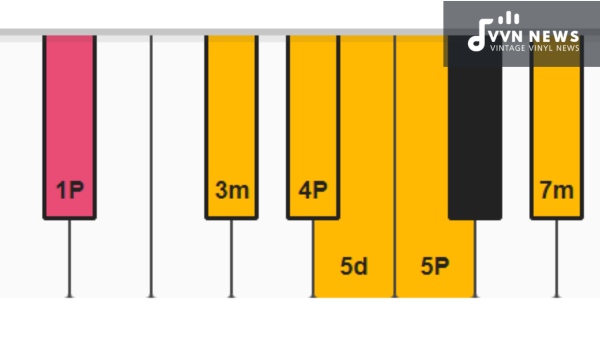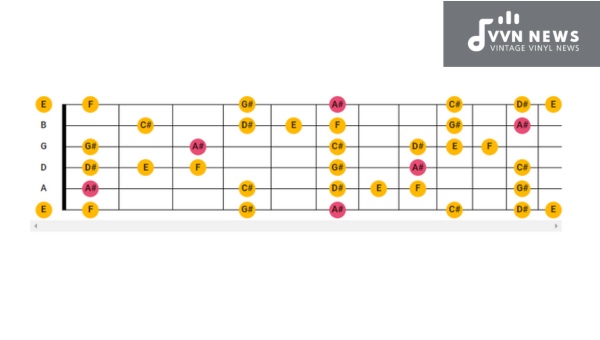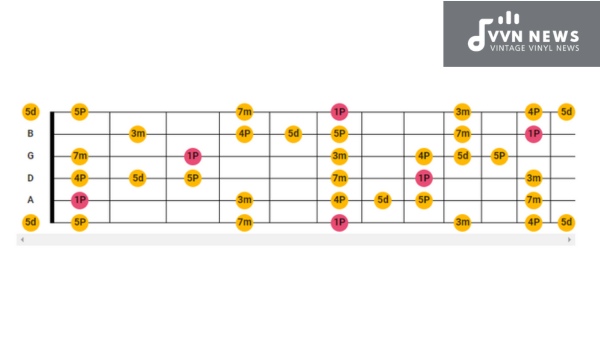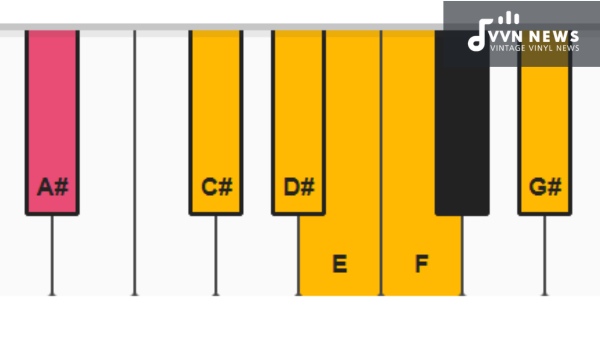The A sharp minor blues scale is a fascinating topic for anyone with an interest in music theory or a passion for the emotive power of the blues.
This particular scale, rich in its musical heritage, is often the backbone of soul-stirring solos and deeply expressive melodies.
It captures a certain nuance that’s both complex and universally moving, offering guitarists and other musicians a palette for painting sonic landscapes that resonate with listeners’ deepest emotions.
Determining how to navigate through the A sharp minor blues scale can elevate your playing from simply hitting notes to truly conveying stories through your instrument.
Whether you’re looking to refine your improvisational skills or add some depth to your musical compositions, getting to grips with this scale can unlock new levels of creativity.
We’ll take you through its structure, its roots in blues history, and how you can apply it to make your own music come alive with authenticity and feeling.
The Notes of the A Sharp Minor Blues Scale
The A sharp minor blues scale is a six-note scale consisting of the following sequence: A#, C#, D#, E, F, and G#.
The scales’ distinct sound arises from the inclusion of a flattened fifth, the E note in this case, which is known in musical terms as the blue note.
This blue note injects that quintessential bluesy feel into melodies. The scales’ structure can be envisioned as a minor pentatonic scale with an added chromatic passing tone (the blue note) that bridges the gap between the fourth and fifth intervals, thereby creating its unique and expressive sound.
Also Read: B Minor Pentatonic Scale [Inject Your Music With Dramatic Flair]
What is the Formula for Creating the A Sharp Minor Blues Scale?

The A Sharp Minor Blues Scale is built on a specific formula, a sequence that musicians can use to construct the scale no matter which instrument they play.
At its core, the minor blues scale is derived from the natural minor scale with an added flat-fifth, also known as the “blue note,” which gives it that unmistakable bluesy sound.
Let’s dive into this formula step by step:
- Start with the Root Note: For our A# Minor Blues Scale, we begin with A#.
- Apply the Intervals: Use this sequence of intervals:
- Whole step (up two frets on a guitar, for example)
- Half step (up one fret)
- Half step
- Three frets (a minor third)
- Whole step
3. Plug in the Notes: Applying this interval pattern starting with A#, you’ll get the following notes:
- A# (Root)
- C#
- D#
- E (The critical “blue note” that gives it character)
- F#
- A
This sequence will allow you to play an octave of the blues scale, and you can extend it both lower and higher by repeating these intervals.
Keep in mind that although we’re centered around A Sharp here, the beauty lies in this transposable blueprint; change your starting note, and you can apply this same formula to create any minor blues scale.
Also Read: A Sharp Minor Pentatonic Scale [Unique Harmonic Possibilities]
Playing the A Sharp Minor Blues Scale on Different Instruments
The sharp minor blues scale is a versatile and soulful tool and understanding how to play it on various instruments can be incredibly rewarding.
Let’s explore the scale’s execution on guitar, piano, and saxophone.
On Guitar
For guitarists, the A sharp minor blues scale can be approached with a common box pattern:
- Start at the 6th string, where your index finger holds down the 6th fret.
- Play the 8th fret with your ring finger on the same string.
- Move to the 5th string and play 5-6-8 (frets) using index, middle, and ring fingers.
Continue this pattern across strings until you’ve covered all six strings. Remember to use alternate picking for a smoother sound.
On Piano
On piano, each key maps directly to a note:
- Find the A♯ note — usually the first black key in a group of three.
- Play these keys in sequence:
- A♯, C, C♯, D♯, E, F♯, and then back to A♯.
It’s laid out linearly, which makes visualizing this scale easier than on fretted instruments. Working both hands in octaves can help achieve dexterity.
On Saxophone
Saxophonists will need breath control as they navigate through notes:
- Begin with lower octave A♯ (using octave key).
- Progress through B#, C#, E natural (open keys), F#, followed by G#.
- Use full breaths for each note ensuring tonal quality and pitch accuracy.
Each instrument has its nuances but starting slow and practicing regularly is fundamental across them all.
Use metronomes for timing precision when scaling up or down these scales.
Also Read: A Sharp Major Blues Scale [Boost Your Guitar Solo Skills]
A Sharp Minor Blues Scale vs Major Blues Scales

When discussing the A Sharp Minor Blues Scale, it’s imperative to differentiate between minor and major blues scales.
This scale is inherently minor, indicated by its flat third degree, which exudes a more somber tone compared to its major counterpart.
Minor Blues Scale Structure:
To construct the A Sharp Minor Blues Scale, we start with the following sequence of notes:
- A# (root)
- C# (minor third)
- D# (perfect fourth)
- E (flat fifth/blue note)
- F# (perfect fifth)
- G# (minor seventh)
This format is what gives this minor blues scale its uniquely moody and soul-searching quality.
On the flip side, we have the A Sharp Major Blues Scale, which incorporates a major third and has a more upbeat vibe:
Major Blues Scale Structure:
The series of notes for this one looks slightly different:
- A# (root)
- B# (major second)
- Cx/D (sharp second/natural third)
- Dx/E (augmented fourth/blue note)
- Ex/Fx/Gb (flat sixth/minor sixth)
Both scales boast the addition of blue notes, those tension-creating pitch bends that are characteristic of the blues genre, but their tonal contrasts make them fit different emotional narratives in music composition and performance.
Learning both scales not only widens your expressive range but also equips you with a more nuanced understanding of blues music’s dualistic nature.
Also Read: A Flat Minor Pentatonic Scale [Unleash Subtle Tension In Your Music]
Effective Practice Tracks for the A Sharp Minor Blues Scale
When you’re learning to master the A sharp minor blues scale, it’s crucial to have a set of practice tracks that highlight its versatile nature and help embed its sound in your ear.
Here’s a rundown of several effective practice tracks you can use to hone your skills:
- Slow Blues in A#: Start with a track that lays down a slow, simmering blues groove in A sharp. The languid tempo allows you to really delve into each note and feel the emotional weight of the scale.
- Funk Groove Backing Track: Funk tracks often use minor blues scales. Find one in A sharp (or transpose if needed) to practice blending bluesy tones with funk’s rhythmic punch.
- Jazz Blues Progressions: A classic jazz blues progression in A sharp gives you a more complex chord structure to navigate while applying the scale, sharpening your improvisation acumen.
- Rock Ballad Backing Track: Rock ballads frequently flirt with blues tonalities. An A sharp ballad will enable you to layer the minor blues scale over sweeping, powerful chords.
- Major Blues for Contrast: Practice along with major blues tracks by deliberately using the minor scale for solo sections. This contrast will help train your ear and improve your feel for when and how to use the minor blue notes effectively.
Each of these genres presents unique challenges and learning opportunities.
As you play along, focus on how the scale fits within different harmonic contexts and work on phrasing that complements each style’s inherent feel.
How does ear training benefit someone learning the A Sharp Minor Blues Scale?

When it comes to mastering the A Sharp Minor Blues Scale, ear training is an invaluable skill set that can have a profound impact on your musicianship.
Here are some crucial points illustrating how ear training benefits learners of this evocative scale:
- Enhanced Scale Recognition: Ear training helps you identify the distinct sound of the A Sharp Minor Blues Scale, allowing you to recognize it when you hear it in music. This skill is key for learning songs by ear and applying the scale creatively.
- Improved Improvisational Skills: With ear training, you’re better equipped to anticipate which notes will resonate best in a given musical context, making your improvisation more fluid and expressive.
- Greater Musical Flexibility: Being able to pick up nuances by ear aids in transitioning between different scales and modes, including switching from the natural minor scale to its blues variant.
- Faster Memorization: By internalizing the sound of each interval within the scale, you strengthen your ability to memorize patterns and sequences without solely relying on visual cues or fretboard patterns.
By investing time into developing your ear while exploring the A Sharp Minor Blues Scale, you’re not only expanding your technical toolkit but also deepening your overall musical intuition. This combination can take your blues playing from good to great.
Music Featuring the A Sharp Minor Blues Scale
Encountering the sounds of the A sharp minor blues scale woven into music truly showcases its versatile nature.
This sonic fingerprint can be found in various genres, where its distinctive mood is employed to evoke deep emotions.
For instance, the sultry track “Still Got the Blues” by Gary Moore employs scales closely related to the A sharp minor blues territory, granting the song its heartfelt tension and release.
As guitar riffs cry out with crisp bends and soulful vibrato, one can hear fragments resonating with an A sharp minor blues character.
Blues-rock enthusiasts might recognize nuances of this scale in Led Zeppelin’s iconic “Since I’ve Been Loving You.”
The song’s lead guitar work, rich with dynamic bends and emotive phrasing, delves into notes that share an affinity with our focal scale.
Jazz aficionados can turn to pieces like Thelonious Monk’s “Round Midnight,” where improvisational solos incorporate notes aligned with the color and contour of the A sharp minor blues scale.
The moody ambience set forth by such melodies illustrates how this scale punctuates music with a potent expression of soulful depth.
Each example utilizes elements from within or neighboring our main focus scale.
Modern blues artists often explore these tones in their quest for fresh yet familiar feelings in their guitar solos or plaintive vocals.
While explicit instances tailored exclusively to feature an “A Sharp Minor Blues Scale” may not be commonplace due to common transpositions to more guitar-friendly key centers like A Minor or E Minor Blues Scales, these songs above do offer a temporal peek into its beautifully haunting muse.
Also Read: G Sharp Minor Pentatonic Scale [Add Dimension To Your Music]
FAQs on the A Sharp Minor Blues Scale
What is unique about the A Sharp Minor Blues Scale?
The A Sharp Minor Blues Scale infuses traditional minor tonality with a bluesy feel, thanks to the added flat fifth, giving it a distinctive, soulful sound.
Can I use the A Sharp Minor Blues Scale for genres other than blues?
Absolutely! While it’s rooted in blues, this versatile scale can also add depth to rock, jazz, and even pop music compositions.
Is there a simple pattern for memorizing the A Sharp Minor Blues Scale on guitar?
Yes, there’s a box pattern that many guitarists learn which makes playing this scale easier to remember and improvise with across the fretboard.
How does practicing with the A Sharp Minor Blues Scale improve my improvisation skills?
Practicing this scale helps you internalize its intervals and textures, enabling more expressive and spontaneous improvisation during solos.
Are there common chord progressions that work well with the A Sharp Minor Blues Scale?
A typical 12-bar blues progression in A sharp minor is an excellent framework for utilizing this scale effectively.
Conclusion
As you delve into the intricate patterns of the A Sharp Minor Blues Scale, understanding its structure and the emotion it can evoke will deepen your musical expression.
Remember, the journey through scales is more than memorization; it’s about feeling each note resonate within you.
Embrace regular practice, explore historical contexts, and, most importantly, infuse each performance with your unique touch.
This knowledge becomes part of an ever-expanding toolkit, empowering your storytelling through melodies that speak to the soul.








